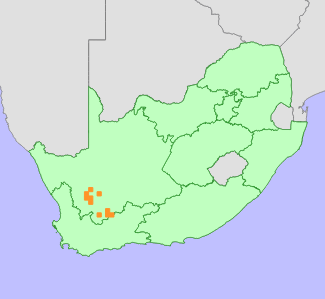|
Scientific Name | Jamesbrittenia incisa (Thunb.) Hilliard |
Higher Classification | Dicotyledons |
Family | SCROPHULARIACEAE |
Synonyms | Chaenostoma stenopetalum Diels, Erinus incisus Thunb., Lyperia incisa (Thunb.) Benth., Sutera esculenta Bond, Sutera incisa (Thunb.) Hiern, Sutera stenopetala (Diels) Hiern |
National Status |
Status and Criteria | Vulnerable B1ab(iii,v) |
Assessment Date | 2020/02/28 |
Assessor(s) | L. von Staden |
Justification | Jamesbrittenia incisa has a restricted distribution range, with an extent of occurrence (EOO) of 4750 - 9365 km². It is declining across its range due to overgrazing and drought. The number of remaining locations is very uncertain, but is estimated to be fewer than 10. It is therefore listed as Vulnerable under criterion B. |
Distribution |
Endemism | South African endemic |
Provincial distribution | Northern Cape |
Range | This species is endemic to South Africa, and is found on the Roggeveld Escarpment and in the Western Karoo, from north-east of Calvinia to the Nuweveld Escarpment south of Fraserburg. |
Habitat and Ecology |
Major system | Terrestrial |
Major habitats | Roggeveld Karoo, Hantam Karoo, Western Upper Karoo, Bushmanland Basin Shrubland, Roggeveld Shale Renosterveld, Hantam Plateau Dolerite Renosterveld |
Description | It occurs among rocks on dolerite outcrops. |
Threats |
| This species is highly palatable and is heavily grazed by livestock. The majority of specimens collected to date note that this species is highly desirable to stock and that shrubs survive only in highly sheltered places in dolerite outcrops (Hilliard 1992). Recent field surveys indicate that its habitat is in poor condition due to prolonged overgrazing, which is being exacerbated by climate change-related droughts. |
Population |
This species is extremely rare and localized, and is suspected to be declining due to overgrazing across its range. During recent surveys of its habitat (2005-2015), only two subpopulations were recorded. It has been known to be threatened by overgrazing since the 1990s (Hilton-Taylor 1996), but there has been no monitoring of the population, and therefore it is not possible to quantify the impact of grazing on the population. Records from the 1970s and 1980s, which are few, indicate that subpopulations were then already small, and all were being impacted by heavy overgrazing. The majority of occurrence records date from the 1960s. The number of remaining locations is very uncertain. It could be as few as two or three, but the eastern part of this species' range is also botanically poorly explored, and it may be overlooked. It has been recorded at only 11 locations in total, and is likely to be locally extinct at some of these.
|
Population trend | Decreasing |
Assessment History |
Taxon assessed |
Status and Criteria |
Citation/Red List version | | Jamesbrittenia incisa (Thunb.) Hilliard | VU B1ab(iii,v) | Raimondo et al. (2009) | | Jamesbrittenia incisa (Thunb.) Hilliard | Vulnerable | Hilton-Taylor (1996) | | Sutera esculenta Bond | Vulnerable | Hall et al. (1980) | | Sutera stenopetala (Diels) Hiern | Uncertain | Hall et al. (1980) | |
Bibliography |
Hall, A.V., De Winter, M., De Winter, B. and Van Oosterhout, S.A.M. 1980. Threatened plants of southern Africa. South African National Scienctific Programmes Report 45. CSIR, Pretoria.
Hilliard, O.M. 1992. New names and combinations in Jamesbrittenia (Scrophulariaceae - Manuleae). Edinburgh Journal of Botany 49(2):225-233.
Hilliard, O.M. 1994. The Manuleae: a tribe of Scrophulariaceae. Edinburgh University Press, Edinburgh.
Hilton-Taylor, C. 1996. Red data list of southern African plants. Strelitzia 4. South African National Botanical Institute, Pretoria.
Raimondo, D., von Staden, L., Foden, W., Victor, J.E., Helme, N.A., Turner, R.C., Kamundi, D.A. and Manyama, P.A. 2009. Red List of South African Plants. Strelitzia 25. South African National Biodiversity Institute, Pretoria.
Snijman, D.A. 2013. Plants of the Greater Cape Floristic Region 2: The extra Cape flora. Strelitzia 30. South African National Biodiversity Institute, Pretoria.
|
Citation |
| von Staden, L. 2020. Jamesbrittenia incisa (Thunb.) Hilliard. National Assessment: Red List of South African Plants version 2024.1. Accessed on 2025/12/24 |
 Comment on this assessment
Comment on this assessment


